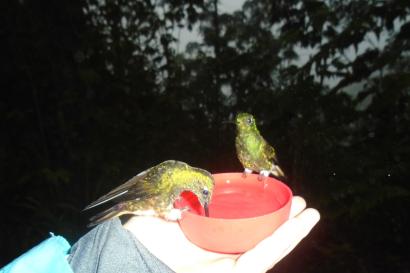I have used or heard these four words—chévere, gracias, sigo, y volcán—a countless number of times during my first week here in beautiful Ecuador. “Chévere” is the Quichua word for “cool!” It is thrown around in all sorts of contexts such as making plans, talking about people and places, or describing an experience. I think we all know “Gracias,” and it comes out of my mouth at least 30 times a day. The bus fare collector says “Sigo,” which simply means, “continue” in this context on the ride to and from school each day. It sounds more like “A Quito, a Rio Coca! Vamos! Sigo! Sigo! Sigo! Sigo!” as he barely hops back on the bus going 10 mph. The bus rides here are incredibly similar to the daladala bus rides back in Tanzania. They are always a fun way to start and end your day. Lastly, Quito is surrounded by “volcanes” or volcanoes, and so they are often a topic of conversation. These neighboring volcanoes dispersed throughout the Andes create a really remarkable sight. I don’t think that I will ever get tired of them.
A funny thing occurred to me. It feels like I have been here for over a month now. Many of the other students here, Universidad de San Francisco de Quito’s (USFQ) faculty, and my host family all already seem so familiar despite the short amount of time that I have been here. Students in the GAIAS program come from all of the United States—the Midwest, the Northeast, Florida, Alabama, another Texan (yeehaw!), California, and the Pacific Northwest. There are also around 8,000 other Ecuadorian and international students attending classes at USFQ. We have already gone out with some of the Ecuadorian students through the “Ecuabuddies” program, and also plan to play some pick-up soccer tonight. This has promoted a diverse variety of perspectives and backgrounds, which I know will make for an overall enriching experience during my time abroad.
We had an intensive Spanish module all of last week to help prepare us for our time here. Several of the homestay families, including my own, speak decent English in Quito. However, families out in the Galápagos are far more likely to speak exclusively Spanish. With that said, I am trying to brush up and improve my Spanish as much as I can during this first month. Then, this past Monday I started my first class module, Wildlife Conservation and Management. My background in biology is more concentrated in domestic biology from my previous animal science major. Nonetheless, many of the topics have been engaging and have resonated with issues that I observed firsthand in Tanzania this summer. We have our first field trip to the Maquipucuna Cloud Forest Reserve on Thursday and Friday. I am incredibly eager for this trip and the rest of the module’s adventures to come.
On Sunday, about twenty of us decided to take the day to hike Rucu Pichincha, the 16,000-foot volcano that looms over Quito. The hike began with an unbelievable view of the city down below and a lush variety of flower and plant species, but quickly turned into sand, scree slopes, and volcanic rock. The final 500-foot ascent must have taken at least an hour to climb. A majority of us ended up reaching the summit within a few hours. The view of the clouds and specks of buildings below you from the summit was breathtaking to see. Rucu Pichincha was easily one of the most exhilarating and rewarding formations that I have hiked. It certainly made you realize how small we are in this world. Getting back down to Quito’s elevation at around 9,000 feet was such as satisfying relief!
¡Hasta la próxima!

Julian Garcia
<div>Hi there all! My name Julian Garcia and I was proudly born and raised in San Antonio, Texas. I am in my senior year at Cornell University studying International Agriculture and Rural Development with interests in sustainable cropping systems and economic development. In my free time, you can find me hiking in the Adirondacks, spelunking 100 feet underground in a cave, trying to cook up something tasty, or reading a Hemingway novel. I hope you enjoy the blog!</div>







